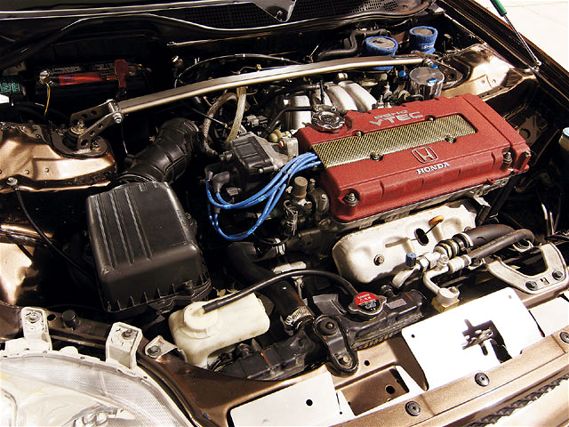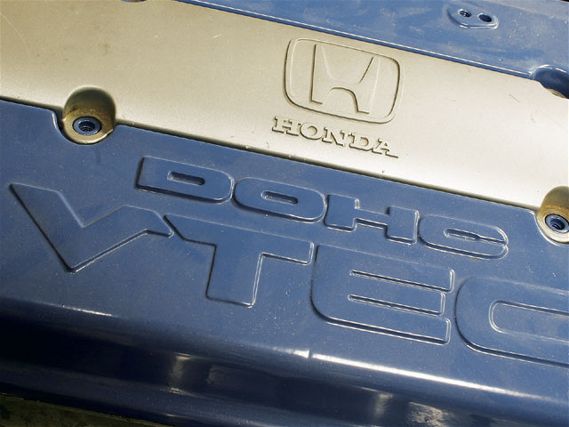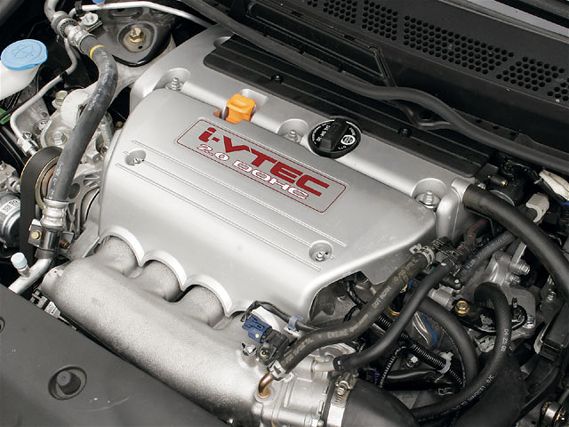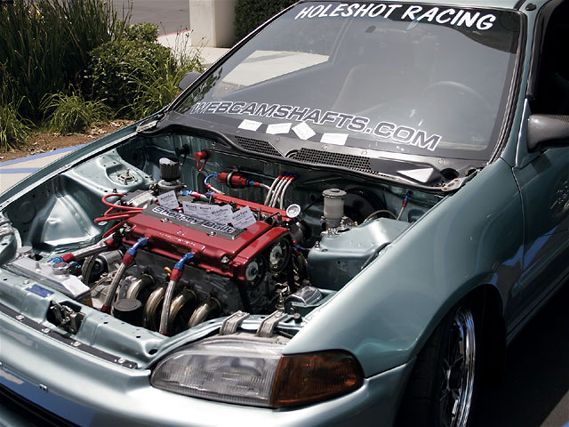 | Engine Swaps - Exhaust Notes May 2008
| Engine Swaps - Exhaust Notes May 2008
Big Power B: CTR VS. ITR
I want to build a 220hp naturally aspirated B-series motor. My question is: Is it possible to make that kind of power without boost? If it is possible to make that much power, what kind of parts will get me there? Also, can I do it with a CTR motor or should I go with an ITR motor?
-Thanks, Victor Costa via the Internet
Horsepower boils down to cylinder pressure-you've either got it or you don't. Turbochargers and superchargers make increasing cylinder pressure rather easy but that doesn't mean it's the only way to get things done, it's just a bit more difficult when working within naturally aspirated parameters. Your 220hp target is reasonable though. We're assuming your target number is based off of horsepower measured at the wheels since anything else wouldn't be a whole lot higher than some of Honda's current four-cylinders in stock trim. No matter how you look at it, displacement is good for horsepower. Starting with the 1.8L ITR engine will put you ahead of the curve right off the bat. Please don't misunderstand, the 1.6L CTR has a lot going for it-it's one of the most geometrically sophisticated Honda engines ever but, facts are facts, and .2 liter of extra displacement will help you. Of course, you won't be able to do much with those extra cubic inches if you aren't able to fill them with enough air and fuel. Make sure your intake and exhaust paths are as free as possible and that your camshafts are able to lift the valves high enough and keep them open long enough to allow for proper ingestion-this will also improve dynamic compression ratios, which means more power. Fuel will need to be addressed as well otherwise you'll end up with a whole bunch of extra air leftover with nothing to burn. Make sure your fuel pump is up to task and fit the engine's rail with a minimum of 310cc injectors. The ITR's static compression ratio will also likely need to be nudged upward but isn't exactly mandatory depending on a variety of factors like valvetrain, intake and exhaust selection. Fortunately, such power figures aren't all that unrealistic. The recipe's out there and the power's been made. The key here is parts combination and proper tuning. You might end up with all the best parts but if you can't get them to work together, you'll be left spinning your wheels, figuratively, not literally.
 | Engine Swaps - Exhaust Notes May 2008
| Engine Swaps - Exhaust Notes May 2008
A Case For The Accord
I am a longtime reader and lover of Hondas. I have a dilemma though. I am looking for a Honda. I am getting interested in Accords but I want to know more about them. I hear everything about Civics and, don't get me wrong, they are another choice of mine. I just would like to see what could be done to an Accord on a reasonable, cheap budget. Could you tell me about the F20B compared to the H22A?
-Thanks a lot, Colin Ernst via the Internet
The Accord is a great car. Don't let anybody tell you otherwise. Is it heavier than a Civic? Yes. Does it have the same level of aftermarket support? Not really. Don't let the details stop you from going the Accord route though-they've still got plenty of potential. Take any of the '90-'97 models, for example. Twin-cam H-series swaps are just a bolt-in away and that's using all factory parts. As for the differences between the F20B and H22A, there are a few. To say that the F20B is just a de-stroked H22A would be a discredit. The F20B's cylinder walls are cast-iron, not FRM (fiber-reinforced metal) lined like the H22A's. Its rods and pistons are stronger. It does indeed have a shorter stroke, which translates into a longer rod and more favorable rod ratio. All of this means higher engine speeds and no real reason to crack open that bottom end for parts replacement. It's important to note that there's not a whole lot of aftermarket support for this particular F-series though. The valves, pistons, rods and crank are all different than the H22A's, which means replacing them could be a lot of trouble. We suggest going the H22A route. It might not be as sophisticated as the 2.0 liter but parts availability will make your life easier.
 | Engine Swaps - Exhaust Notes May 2008
| Engine Swaps - Exhaust Notes May 2008
Decisions, Decisions: Engine Management
I own a '06 Honda Civic Si. As you know, Hondata is not going to be coming out with a K-Pro, which is not cool. The only way I can do it is to go with an '02-'04 ECU, which I am not sure is a good idea. What do you think? I am debating between the Hondata re-flash, AEM EMS, GReddy e-Manage or GReddy v-Manage. What would you recommend? I go on the forums and that's not helping. For every person who says it's a good idea to use one of them, there is someone else saying they recommend something else. So what do I do? I turn to my buddies and they tell me to do something totally different. One of my friends has a piggyback ECU with a monitor that sits in the cab. I can't think of the name. It's really cool. I just don't know. I am trying to go the route with my car where I am not going to regret what I did.
I already have a cold air intake, custom exhaust, a Stage 4 clutch and flywheel and lowering springs. Hell, I am already wondering if I shouldn't have gone with a Stage 2 or even stayed with the stock clutch until I get more power. Any input is greatly appreciated.
-Thank you, Dave / Jacksonville, N. C
Your engine management needs really depend on future modifications. Judging by your situation, we'd suggest going with Hondata's reflash. You'll pick up an easy 25-30 hp in the midrange without sacrificing driveability or swapping computers. However, if you plan on going the forced-induction route or significantly modifying your engine, the parameters Hondata set you up with likely won't apply. ECU parameters are application specific, which makes tunable stand-alone or piggyback systems so attractive. Both AEM's EMS and GReddy's eManage Ultimate are great systems. Either will allow for larger fuel injector compensation and ignition timing adjustment-two parameters you'll need to be concerned with should you heavily modify your K. Since the EMS is a stand-alone system it allows for a bit more flexibility than the eManage Ultimate but is a more permanent solution when compared to the piggyback. The EMS also requires the services of a professional tuner because it's far more complex than the eManage. Without sounding too much like the people you've talked to already, the truth is, each system has its own merits. While a Hondata re-flash might make sense for the guy who plans on modifying his car little it just won't work for those who plan on going the turbo route or cracking open that bottom end.
DOHC Head, SOHC Block?
I have a '95 Civic VX with the stock D15Z1. This engine has VTEC but it was tuned for fuel economy rather than performance. I would like to put a DOHC VTEC head on but I don't know which ones would fit or make real power. I am looking for about 150 hp for street and some track use. I don't want a setup that's too loud or rough at idle and seeing that to make this kind of horsepower one would need more than basic bolt-ons, do you think it would be better suited to my interests or cheaper to just drop in a new engine? If so, what do you recommend? Remember, I need something that I can drive on the street seeing that this is my only car and I have to drive to and from school everyday. Thanks for any advice you have for me and keep up the good work! P.S. this is my first time tuning a Honda, so wish me luck!
-Alex Ekholm / Cos Cob, Conn.
 | Engine Swaps - Exhaust Notes May 2008
| Engine Swaps - Exhaust Notes May 2008
Well, you can't just slap a twin-cam head on your D-series block. It doesn't work that way. Swapping in an entire DOHC engine is easy enough though and you've got several to choose from. Any of the B-series engines will suit your power, noise and driveability requirements and bolt right into your chassis. Even configuring the new engine's wiring will be a piece of cake since your VX came with VTEC, never mind the fact that it's a different kind of VTEC. As far as driving to school everyday, you've got nothing to worry about. A B-series will be right at home under your hood. In fact, they're offered in your chassis right from the factory in certain Japanese and European models. Hey, you can even get one to pass even the most stringent of smog tests and be completely certifiable given you select the proper B-series engine to begin with. Stick with a '95 model USDM engine and you've got the makings for a street-legal swap.
The Other B-Series
I have a '90 Honda Prelude Si. It has the original B21A1 motor in it and I just recently had a rebuilt transmission put into it. I have a few mods put to the car already, cold air intake, exhaust system, etc., but I wanted to know if there was a site that I could go to get more out of this thing. It's a beast already and I love it, but it's missing kick. Is there anything out there that I can do?
-Justin Arndt / Lynchburg, Va.
Justin, we hate to be the ones to tell you this but you've already got two strikes against you. First, there just aren't a lot of parts available for the B21A1. Second, the B21A1 sucks. Sorry, but it doesn't have a lot going for it. Sure, it sounds good at first-2.1 liters of displacement in B-series-like packaging, a DOHC configuration and decent torque right out of the box. Unfortunately the fun ends there. Its composite headgasket and FRM cylinder walls are partly to blame. Its less-than-ideal rod ratio doesn't help either. The headgasket can be a real problem, especially once you start doing fun things like adding boost or even compression. Despite your best efforts, they'll just never seal as good as the multilayer, metal gaskets found on other engines. There's nothing inherently wrong with FRM. It helps resist cylinder wear and its heat-transfer properties are superb. The problem is finding forged pistons compatible with the stuff. You really won't, especially for your engine, which means you'll need to re-sleeve the block with non-FRM liners. We suggest looking into an H22A engine swap. Before you say anything, we know that the H has also got FRM liners but there's also a heck of a lot more support for this engine than your B21A, which means reliable horsepower is just a swap away.
Timewaster Of The Month
Hello, my wife took her two-door '98 Honda Civic coupe (sunroof, EX model) into the shop to get repainted. When we picked it up the EX was replaced with a DX on the back and we both noticed it. Is this a concern?
-Thanks, Michael / Plainsboro, N.J.
We'd definitely be concerned. You just can't go around swapping emblems like that and expect everything to be OK. Did you make sure your sunroof is still there? How about your D16Y8? VTEC engines tend to mysteriously disappear once EX emblems go missing.
Got Questions, Comments, Love Or Hate?
Send Your Letters To:
[email protected]
Or Snail Mail To:
2400 E. Katella Avenue, Suite 1100
Anaheim, CA 92806
